条件表形氮化镓增强黏结非线性剪切蠕变评价
IF 3.2
3区 材料科学
Q2 ENGINEERING, CHEMICAL
International Journal of Adhesion and Adhesives
Pub Date : 2025-05-17
DOI:10.1016/j.ijadhadh.2025.104066
引用次数: 0
摘要
纤维增强聚合物与粘合剂粘合已出现在加强现有结构的重大进展。然而,在温暖的使用温度下(20-50°C),这些粘接接头表现出粘弹性行为,导致难以评估的非线性蠕变。本研究引入了一种利用集成机器学习(EML)模型的新方法,该模型由条件表格生成对抗网络(CTGAN)增强,以评估关节的蠕变响应。初始数据集包括在热室中进行的25次对接剪切蠕变测试的结果,有助于CTGAN生成合成数据集,然后用于训练EML模型。采用“训练-合成-测试-真实”策略可以将构建的EML模型与ctgan -随机森林(RF)模型进行比较,显示出更好的性能。该模型进一步形成了图形用户界面工具的基础,能够准确预测不同条件下接头的剪切蠕变,并为将来的分析提供额外的合成数据。此外,还进行了SHapley加性解释探索,以揭开CTGAN-RF模型的神秘面纱,从而深入了解不同特征对输出结果的影响。本文章由计算机程序翻译,如有差异,请以英文原文为准。
Augmenting nonlinear shear creep evaluation of adhesive joints with conditional tabular GAN
Fibre-reinforced polymers with adhesive bonding have emerged as a significant advancement in the strengthening of existing structures. However, at warm service temperatures (20–50 °C), these adhesive joints demonstrate viscoelastic behaviour, leading to nonlinear creep that is difficult to evaluate. This study introduces a novel approach that leverages Ensemble Machine Learning (EML) models, enhanced by Conditional Tabular Generative Adversarial Network (CTGAN), to assess the creep response of the joints. The initial dataset, comprising results from 25 butt shear creep tests conducted in a thermal chamber, facilitated the generation of a synthetic dataset by CTGAN, which was then used to train the EML models. Employing the “Train-Synthetic-Test-Real” strategy allowed for the comparison of the constructed EML models, with the CTGAN-Random Forest (RF) model demonstrating superior performance. This model further forms the basis of a graphical user interface tool, enabling accurate predictions of the shear creep in the joints under different conditions and the production of additional synthetic data for future analyses. Moreover, the SHapley Additive exPlanations explorations were conducted to demystify the CTGAN-RF model, offering insights into the impact of different features on the output results.
求助全文
通过发布文献求助,成功后即可免费获取论文全文。
去求助
来源期刊

International Journal of Adhesion and Adhesives
工程技术-材料科学:综合
CiteScore
6.90
自引率
8.80%
发文量
200
审稿时长
8.3 months
期刊介绍:
The International Journal of Adhesion and Adhesives draws together the many aspects of the science and technology of adhesive materials, from fundamental research and development work to industrial applications. Subject areas covered include: interfacial interactions, surface chemistry, methods of testing, accumulation of test data on physical and mechanical properties, environmental effects, new adhesive materials, sealants, design of bonded joints, and manufacturing technology.
 求助内容:
求助内容: 应助结果提醒方式:
应助结果提醒方式:


